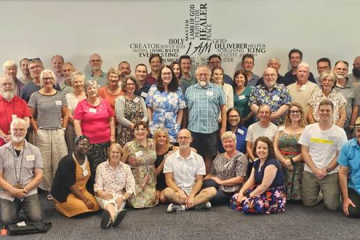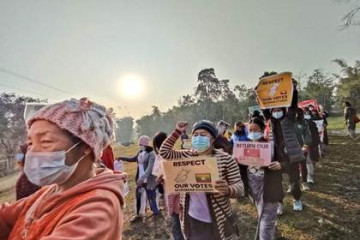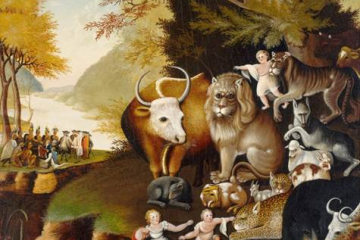Exodus 14: 19-31, Psalm 114
If you spent any time at all in Sunday School you probably know a song that posed the question, “How did Moses cross the Red Sea?”
There’s a lot going for this song. It does that great thing for engaging an audience, especially a younger audience, of allowing them to become the experts, “Did he swim? No, no! Did he sail? No, no. Did he fly? No, no, no, no.” And there’s the hook with the rhyming, onomatopoeic sounds, “God blew with his wind, puff, puff, puff, puff. He blew just enough, nuf, nuf, nuf, nuf.” And finally, the answer! “And through the sea, God made a path, that’s how he got across.”
But reflecting on this passage this week it seemed to me there were several other answers for ‘how did Moses (and the Israelites) cross the Red Sea’ too! After all, this is not a straightforward text! Scholars tell us it was woven together from different narrative strands, revealed by the different descriptions of how the waters part, driven back by a strong east wind in one strand and dramatically separated in another, or how the Egyptians came to drown, disoriented by the pillar of cloud and swept into the sea or trapped by returning sea waters. And I am not referring to scientific explanations for how this scriptural event could have taken place. This is not the focus of the writers of the Hebrew Scriptures. Their focus is on what these stories, this text, say about God’s relationship with Israel, Israel’s relationship with God, and God’s activity in our world. In Professor of Old Testament Terence Fretheim’s words, “[this is] a witness to the power of Yahweh and a consequent summons to faith.”
The first other answer, I believe, to ‘how did Moses cross the Red Sea’ is by ‘being still’.
If you know the story you know that after ten plagues had plagued Egypt, Pharaoh finally let Moses people go, but no sooner had he done so, than he and his officials regretted it, “What have we done,” chapter 14, verse 5, “letting Israel leave our service?” So, he gathered, “six hundred picked chariots and all the other chariots of Egypt,” and pursued the Israelites.
And the Israelites were caught, with the sea at their backs, and six hundred plus heavily armed chariots coming towards them. Not a good place to be! No wonder they complain to Moses, “Is this not the very thing we told you in Egypt, ‘Leave us alone and let us serve the Egyptians’? For it would have been better for us to serve the Egyptians than to die in the wilderness.” A response that reveals they are not only caught between the devil (or Pharaoh) and the deep blue sea, but between an identity as slaves and summoning the courage for a new identity, as God’s chosen people bound for the Promised Land.
But Moses’ response is extraordinary. “Do not be afraid, ” he says. (Where have we heard those words before?) “Stand firm and see the deliverance that the Lord will accomplish for you today…” and he finishes with, “You have only to keep still.” Keep still. Trust. Hold on. Sometimes all that we can do in the face of chaos is ‘be still’.
I am reminded of a story pastor Nadia Bolz-Weber tells of doing Clinical Pastoral Education and being paged to a trauma room.
“Inside the trauma room,” she writes, “a nurse was cutting the clothes off a motionless man in his fifties on a table, tubes were coming out of his mouth and arms. Doctors [were] doing things to him not meant for my eyes and sorely misrepresented on TV shows….[one] motioned for paddles, which he then placed on the motionless man’s freshly cracked-open chest.
A nurse stepped back to where I was standing, and I leaned over to her, “Everyone seems to have a job, but what am I doing here?”
She looked at my badge and said, “You job is to be aware of God’s presence in the room while we do our jobs.”
For the rest of her time in the hospital, Nadia writes, “in that messy chaos, [her] job was to stand there and be aware of God’s presence in the room. Kind of a weird job description, but there it was, and in those moments,” she writes, “I felt strangely qualified. I didn’t have the slightest idea what to say to someone who just had shoulder surgery, but I couldn’t help but feel God’s presence in the…room.”
Sometimes the only way to respond to the messy chaos of the Red Seas of our lives is to ‘be still’; to become aware of God’s presence in those situations.
The second other answer to ‘how did Moses cross the Red Sea’ is by ‘keeping on going’.
Exodus 14:15 says, “Then the Lord said to Moses, “Why do you cry out to me? Tell the Israelites to go forward.” Or as it is written – and I have never forgotten this – in my Children’s Living Bible, “Then the Lord said to Moses, ‘Quit praying and get the people moving! Forward, march!’”
Sometimes we need to keep still, but at other times we must keep going. The people of Israel had to start making their way across the Red Sea, even though that way seemed hard and scary and very uncertain.
This has been my experience this year. As I wrote a few months ago in ‘Sunday to Sunday’ (and this is not news to any of you) 2020 has been a very difficult year; with the aftermath of Martin’s resignation and my father’s ill-health and all the ongoing challenges to doing ministry that Covid has presented; and all these difficulties have sometimes made me wonder if there is a way ahead. But as I wrote in that Sunday to Sunday, knowing God is with us, sometimes we just have to do ‘the next right thing’ with as much integrity and courage and vulnerability as we can, sometimes we just have to keep moving, knowing we move forward with a companion God, a God who says to us, “Do not be afraid, I am with you”.
The third other answer to ‘how did Moses cross the Red Sea’ is an odd one – but I think crossing the Red Seas of our lives also requires us to engage in ‘lamenting’.
The story of the Red Sea crossing is full of creation imagery. Just as, “In the beginning when God created the heaven and the earth the earth was a formless void and darkness covered the face of the deep,” here again in Exodus God dives into the deep and dark and messy parts of human history and creates a people, as I mentioned above, with a new identity. People who are no longer slaves but chosen by God. And in doing so, God defeats the anti-creational forces of enslavement, domination, and violence represented by Pharaoh. But the text does not allow this to become a tribal ‘us and them’ account. It also remembers the deaths of the Egyptians, “and Israel saw the Egyptians dead on the seashore.”
In a Jewish commentary on this passage, the rabbis speak of the angels desiring to sing a song of praise before God in response to this victory over the Egyptians and God says to them: “My handiwork [the Egyptians] are drowning in the sea, and you are reciting a song before me?…God is not gladdened by the downfall of the wicked.”
As we make our way through the dark and deep and messy parts of our lives, our human history, we are called to lament for our suffering and for the suffering of others. You may have caught the news of the 9-11 memorials in New York and seen the clip of the Rev Phillip Jackson standing in the graveyard of Trinity Church Wall Street about to ring the bell of hope which is rung every year at 8:46am – the time when the first plane flew into the north tower – and saying, “In addition to remembering those who lost their lives on September 11, 2001, we also have in our hearts and in our minds and in our prayers and in our souls, we remember the almost 24,000 New Yorkers who died this year from the Covid 19 virus….We lost almost 24, 000 of our fellow NY this year…I don’t know about you, but for me, that is a heartbreak and a loss that we will remember forever.”
We are called to lament.
And finally, my final other answer for ‘how did Moses cross the Red Sea’ is ‘by singing’; by singing God’s praises. As well as taking time to lament, we must take time to ring out and sing our hope. This is what will keep us going.
If you know the text, you will know this is exactly what Moses and his sister, Miriam (I like to get a mention of Miriam in where I can!) did. They sang, “I will sing unto the Lord, for he has triumphed gloriously. The horse and rider – the ancient symbols of enslavement and domination and violence – thrown into the sea.”
Some of you may know this, but this song has been kept alive by Aboriginal communities. My Miriam’s Aboriginal studies lecturer was telling her that when she heard ‘Ngarra burra ferra’ sung in the movie, The Sapphires, she remembered her grandmother singing it and then got angry that another white person’s hymn had been imposed on Aboriginal people, but actually the history is more interesting. The song originates in a visit from the Fisk Jubilee Singers, an African American university choir, to Mologa mission on the Murray River in 1887. Fisk University was one of the newly formed black colleges and universities established to educate freed slaves, founded in 1870 shortly after Emancipation in the US in 1865, and the choir was on a worldwide tour to raise funds for the university.
They sang there an African American spiritual called, ‘Turn Back Pharoah’s Army’. The tradition is that Theresa Clements who worked with the mission teacher, Thomas James, composed the Yorta Yorta version of this song which soon became owned by the Bangerang people, or, in fact anyone who identified with Yorta Yorta people.
But they did not keep the song to themselves. It was a song to sing out to all Australians, as a statement. Professor Bain Attwood found that, as William Cooper and others negotiated with officials as to how best commemorate the founding of Melbourne, the Aboriginal leadership was able to include a performance of their Biblical song of defiance and hope.
“In the concert held to mark Melbourne’s foundation in May 1937, the grand finale was the aboriginal choir’s singing of a ‘Burra Phara’, an African American spiritual, translated into the Yorta Yorta language, which expressed their identification with the Jews as the dispossessed of the Book of Exodus…”
How did Moses cross the Red Sea? How do we continue to cross the Red Seas of our experience, in our Individual lives and as a community of hope, a people who also are God’s loved and chosen people? We do it by being still. Yes, yes. By keeping on going. Yes, yes. By lamenting. Yes, yes. And by continuing to sing songs of defiance and hope and rejoicing in God’s delivering and creating work in our lives and in our world. Yes, yes!
Womraka moses yenyen wala
Wala yepun yepudge
Ngara burra ferra yamini yala
Ngara burra ferra yumini yala yala
Ngara burra ferra yumini yala yala
Ngara burra ferra yumina
Burra ferra yumina
Burra ferra yumina yala yala…


